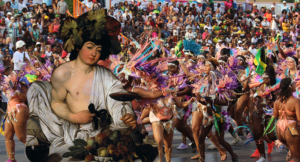
Bacchus, it is said, was born in the city of Thebes within the Greek region of Boeotia. He was the son of Jupiter, the king of the Roman gods, and Semele, the beautiful daughter of the Phoenician hero Cadmus. The story goes that Jupiter lusted after Semele, and Juno, the queen of the gods, learned of this. Rather than dissuade her husband from pursuing an affair, she appeared to Semele and told her to request Jupiter to have sex with her, and to make him swear by death itself that he would make love to her with all of the passion that he did with his wife.
However, this divine hook-up would lead to Semele’s death. The act of a mortal woman having sex with a god ended up killing her, and she was consumed by fire and burned into nothing but ashes. However, the act had made her pregnant, and her conceived child was transferred into Jupiter’s body to keep the baby from being burned as well. It was his father Jupiter, therefore, who gave birth to Bacchus – thus, he was born of both a man and a woman as his two mothers.
Bacchus is frequently represented in Roman art as a young man without a beard, and sometimes his facial features and even his body as a whole bear an effeminate appearance. Bacchus is traditionally shown wearing a crown made of ivy or grape leaves. Sometimes, in one of his hands, he holds a javelin or spear called a thyrsus with a vine garland wrapped around it.
Bacchus was attended by a group of women, and these priestesses were referred to by many titles. Mostly, they were known as Bacchae, because they served Bacchus, but also because, like their wine-guzzling master, they were prone to excessive drinking. For that reason, they were also sometimes called the Mimallones, “the mimickers” because they copied the drunkenness of their divine lord. Sometimes, they were known by the name Maenades, because their ecstatic devotions were mistaken for madness. Other times, they were called Thyades due to their forceful nature.
The term Bacchanalia describes the initiatory and celebratory rites dedicated to the Roman god Bacchus. These practices, which were intimately tied to the soteriological aspirations of their adherents, were largely inherited from Greek and Etruscan mystery religions, save their notable incorporation of carnality (through the use of inebriation and sexual license). Though extant on the Italian peninsula since approximately 600 B.C.E., these practices began to truly flourish during the third and second centuries B.C.E.
The dramatic increase in the popularity of these rites, coupled with the fact that they encouraged the involvement of various “lesser” citizens (such as slaves, women, and youths), led the Roman Senate to pass an edict banning all unauthorized worship of Bacchus in 186 B.C.E.


